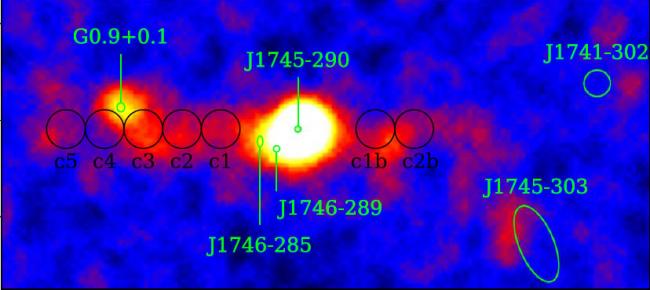- Why do we need an extremely large telescope like the Giant Magellan Telescope?
- Why do galaxies differ so much in size, shape, composition and activity?

VERITAS, the Very Energetic Radiation Imaging Telescope Array System, produced this pseudo-image of the Milky Way' central region in high energy gamma rays. The image is a diagram showing, for each location, the statistical significance of the gamma-ray detection (not strictly the intensity of the light); the most reliable detection, at the bright central spot, has a statistical significance of 38 standard deviations. The image, spanning about one thousand light-years, shows six significant sources as well as extended emission. The results are consistent with the high energy gamma-ray emission being produced by supernovae and their remnants.
Over the past two decades, very high energy gamma ray emission has been detected coming from the direction of the Milky Way's Galactic Center. The Galactic Center hosts many potential sites of particle acceleration including the supermassive black hole Sagittarius A* and remnants of supernova activity spread throughout the region. Electrons, protons, or other particles that are accelerated to speeds close to the speed of light will emit very high energy light - gamma rays - via a range of physical processes that depend on the particle types and the environmental conditions. Each gamma ray packs approximately one hundred million times the energy of the highest energy X-ray photon seen by the Chandra X-ray Observatory. The gamma-ray maps of the region show emission coming from one bright spot near the central supermassive black hole, from several other locations scattered within the central five hundred light-years, as well as a diffuse glow between them. However the limited spatial resolution of the detection facilities made it difficult to pinpoint the precise source(s) of the gamma rays. Astronomers have been working to refine the observations in order to identify the objects and constrain the mechanisms responsible for generating the gamma rays.
VERITAS, the Very Energetic Radiation Imaging Telescope Array System, is a CfA observatory consisting of four 12-m telescopes designed to study gamma rays and located at the Fred L. Whipple Observatory at Mt. Hopkins, Arizona. CfA astronomers Wystan Benbow, Michael Daniel, Gareth Hughes, and Emmet Roache with a large team of their colleagues reanalyzed eight years of VERITAS observations of the Galactic Center region using advanced data reduction algorithms. The team finds that the bright central gamma-ray source is centered on the supermassive black hole (in agreement with some earlier studies) but also cannot exclude some neighboring structures as possible origins. Spectral information, however, implies that electrons are the dominant particles, in turn suggesting that supernova remnant activity with high magnetic fields could be powering the emission, not SgrA*. The absence of detected variability in the source is consistent with this model. The astronomers' analysis of the diffuse radiation within the whole region finds that all the energy in that radiation could have been supplied by a single large supernova event in the past, but it is also consistent with the presence of a population of 10-100 thousand pulsars (themselves remnants of supernovae). CfA scientists are leading the development of a next-generation gamma-ray facility that will be able to make stronger source correspondences and also extend the range of detectable gamma-rays.
Reference: "VERITAS Observations of the Galactic Center Region at Multi-TeV Gamma-Ray Energies," C. B. Adams et al., The Astrophysical Journal 913, 115, 2021.
Related News
Runaway Stars Reveal Hidden Black Hole In Milky Way’s Nearest Neighbor
NASA's Hubble, Chandra Find Supermassive Black Hole Duo
Event Horizon Telescope Makes Highest-Resolution Black Hole Detections from Earth
CfA Celebrates 25 Years with the Chandra X-ray Observatory
CfA Astronomers Help Find Most Distant Galaxy Using James Webb Space Telescope
Astronomers Unveil Strong Magnetic Fields Spiraling at the Edge of Milky Way’s Central Black Hole
Black Hole Fashions Stellar Beads on a String
M87* One Year Later: Proof of a Persistent Black Hole Shadow
Unexpectedly Massive Black Holes Dominate Small Galaxies in the Distant Universe
Unveiling Black Hole Spins Using Polarized Radio Glasses
Projects
AstroAI
DASCH (Digital Access to a Sky Century @ Harvard)
For that reason, the DASCH (Digital Access to a Sky Century @ Harvard) team are working to digitize the plates for digital storage and analysis. The process can also lead to new discoveries in old images, particularly of events that change over time, such as variable stars, novas, or black hole flares.
GMACS
For Scientists
Sensing the Dynamic Universe
SDU Website